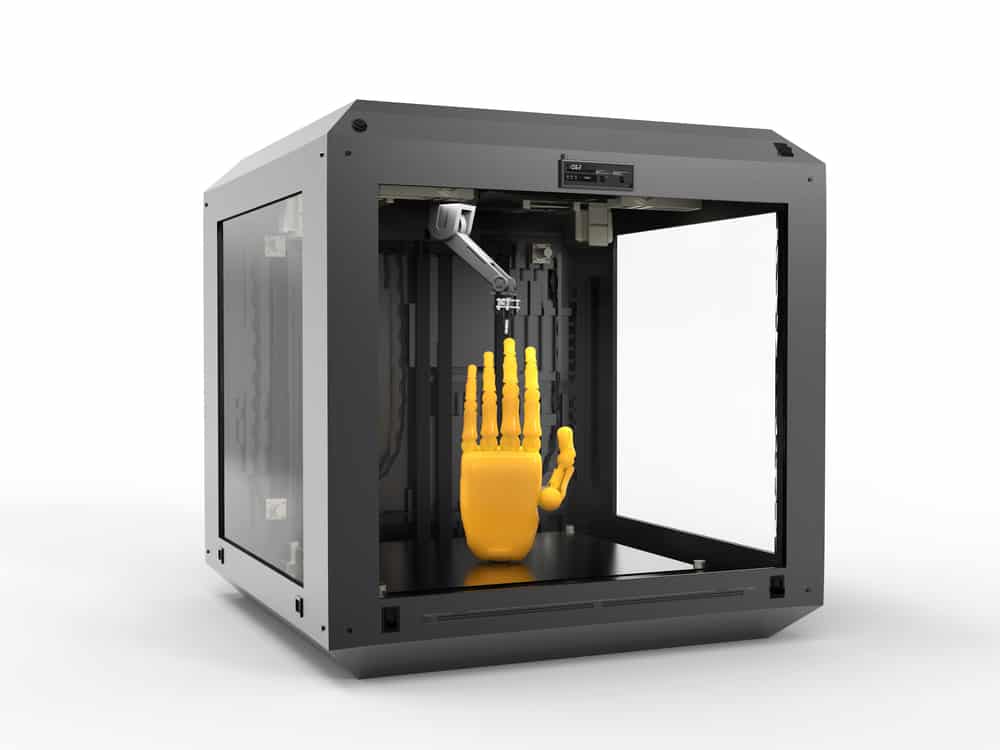This post may contain affiliate links, which means that we get commissions for purchases made through such links, at no additional cost to you. As an Amazon Associate we earn from qualifying purchases.
This post will teach you about curing in 3D printing. The concept of curing in 3D printing is very broad. But having studied wide on it, our team decided to put together this article to explain what post-curing is in 3D printing.
What is curing in 3D printing? Curing (or post-curing, as some people call it) is the process of applying UV light and heat to improve the stability and strength of 3D printed images. This process is particularly important for Stereolithography (SLA) 3D printing, which uses functional UV-sensitive resin.
Post-curing allows the parts of a 3D printed image to attain their highest possible level of strength. But then, there are different methods of curing. And different resins require different degrees of temperature and duration of exposure. As you read on, we will tell you more about curing for 3D printing.

What Is The Reason For Curing 3D Resins?
When you cure 3D resins by exposing it to light, new chemical bonds begin to form within the 3D printed part. Existing bonds also become stronger. As these happen, the material becomes stronger, more stable, and stiffer. The UV light for post-curing can come from a curing device or sunlight. But UV curing under sunlight is slower and weather conditions can affect curing when you use sunlight.
The advantage of using sunlight is that it automatically combines light and heat. But the UV wavelength and temperature depend on the weather condition per time. Thankfully, some post-curing UV chambers also apply heat. Heat application makes the process faster and makes the bonds form more completely.
Some post-curing units use 405nm, while some use wavelengths as low as 10 nm. This means that any light wavelength can achieve curing but time requirement and the consistency of curing may differ. That’s why it’s important to know the ideal wavelength for your 3D parts. We’ll talk more about the factors for selecting a post-curing method later.
How Do You Cure 3D Resin Prints?
The several methods of post-curing in 3D printing include the simple use of light, as well as using both light and heat. Sources of light for post-curing include UV lamps, sunlight, UV nail salons, UV cure stations, and DIY UV curing boxes, among others. As regards heat, high temperatures accelerate curing and allow the bond to form better. The combination of light and heat leads to more stable and tougher material properties than what light alone can achieve.
Since there are different post-curing methods, you must carefully consider your options before choosing a suitable method for your 3D prints. Some of these factors include the type of material you are using, the size of your image, and its intended application.
Lets’ examine these different factors below:
Factors for Selecting a Post-Curing Method
Type of Material
Different resin formulations have a certain range of light wavelengths that will best maximize their mechanical properties. Examples of material types include standard resin, rigid resin, and Grey Pro resin, among others. Most of these resins need 405nm light for post-curing.
Complexity and Size
You can cure small prints with simple UV nail salons, which are usually quite cheap. But if your 3D parts are more complex or the image is larger, you will need a curing unit that provides even exposure. These units have a balanced light source and a turntable that rotates, among other things. These features ensure that curing is consistent throughout the 3D image. For larger images, you may also need a unit that applies both heat and light to make the process faster.
Intended Application
If your applications require high dimensional accuracy, you should use an appropriate unit specifically designed for the material(s) you are using. Dental applications and other prototyping products rely on clear-cut fit and have tight tolerances. So you can’t use generic curing solutions for them.
If the application does not require great accuracy, it means tolerance is more flexible. You can use generic curing solutions for such applications.
✅ Video – How to Build an SLA 3D Print Resin Curing Oven
In this video, Sean Charlesworth will show you the step by step process on how to create an effective generic curing solution for resin parts. Even if you do not intend to build a resin curing oven, this video will help you understand the different components of curing stations and how they work.
Steps for Post-Curing Resin 3D Prints
Although light alone can achieve curing, the ideal post-curing for Resin 3D prints starts with heat. Heat makes the resin’s polymer network available for cross-linking. Light photons then cause cross-linking to happen between the polymers. As the polymers cross-link, the material becomes harder and stronger. This way, curing maximizes the material properties of Resin 3D parts as heat and light work together in controlled synergy.
Let’s take a closer look at the two steps for post-curing resin 3D prints:
Step One: Heat Application
As heat raises the temperature of your 3D printed part, kinetic energy increases and mobilizes the resin molecules. In practical terms, this means that the reactive groups in the material have higher chances of colliding and cross-linking. Some post-curing chambers rotate the 3D parts as heat is applied so that exposure will be even and consistent throughout.
Step Two: Light Application
While heat makes the polymers more available for cross-linking, light photons make the actual cross-linking to occur. Light causes the cross-linking of close-by reactive groups. As new cross-links form, the polymers develop a stronger network and the material attains optimum mechanical properties.
Besides becoming stronger, the resin polymer network also becomes slightly denser. This causes the part to shrink a bit. You should not bother about this, as it is normal. However, this means that you may not get precise dimensions if you use general curing solutions for certain 3D applications.
Applications that require precise dimensions have specified curing solutions. The printer automatically compensates ahead for the shrinkage that will occur due to curing. So when you use the appropriate printer with its specified curing unit, you will still get a dimensionally accurate 3D part.
Related Questions
Do You Have To Cure 3D Prints?
Curing is essential for 3D prints, so you have to do it. Without post-curing, the 3D parts will not reach their highest possible stability and strength. So after printing 3D parts with functional resins in a resin 3D printer, you should proceed to cure the 3D printed image.
The true quality of your printed 3D images will not show until you have post-cured it. The appropriate UV light wavelength will help solidify your 3D part and make it stronger no matter how large or complex it is. But if your 3D part is very large or has a complex design, post-curing might take longer.
Can You Cure Resin without UV Light?
You cannot cure resin without UV light. UV light is vital for curing resin because it helps the 3D image to dry up, harden, and become more stable. But then, there are different sources of UV light for post-curing. You can use direct sunlight, a UV chamber, a UV torch, or a UV lamp.
Curing with sunlight is usually quite slow. Conversely, artificial UV light sources (with high wavelength) cure 3D parts faster. But then, you should be cautious while post-curing UV prints under high wavelength because the process generates heat strong enough to burn your skin.
How Fast Is A Resin 3d Printer?
The speed of Resin 3D printers can range from a few minutes to many hours. Large 3D models that occupy the entire volume of the resin 3D printer can take as long as 20 hours of printing. Draft resin, however, offers rapid prototyping and can print the same 3D part in under six to nine hours.
Ultimately, the decision of the printing method to use is usually not as simple as going for the faster option. You would also have to consider quality, settings, and material type, among other factors.
For more on this, you can read our comprehensive post of the speed of resin 3D printers. In the post, we also compare the speed resin 3D printers with FDM printers.
Conclusion
So far, we have shown you our findings on what curing in 3D printing means. The post explained how curing works and the different methods available. We hope that the information in this post is helpful and valuable for you.
